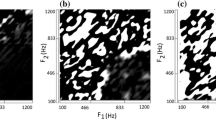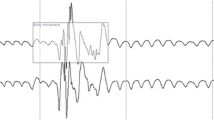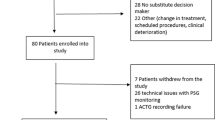Abstract
A computer-assisted method for the evaluation of sleep and breathing in patients showing chronic ventilatory impairment is described and validated. Signals of body and respiratory movements (static charge sensitive bed), air-flow (thermistors), oxygen saturation (SaO2), electro-oculography (EOG), and electromyography (EMG) were recorded overnight and analysed. Using the compressed output graphs of the data and a rapid scoring procedure, stages of wakefulness, non-REM (stages S1–S4) and REM sleep were identified. The procedure allowed analysis of oxygen saturation data separately for each sleep stage. For validation of the method, the sleep stages identified were compared with traditional sleep staging based on a simultaneous recording of EEG, EMG and EOG in 10 patients with chronic obstructive pulmonary disease (COPD) and in 15 patients treated by thoracoplasty (TPL) for pulmonary tuberculosis. The recordings were performed in a patient ward. In total, 32 night recordings were analysed. In the COPD patients, the sensitivity and specificity of the new method were 87% and 84% in detecting non-REM sleep, and 72% and 87% in detecting REM sleep, respectively. In the TPL patients the sensitivity and specificity were 93% and 89% with respect to non-REM sleep, and 92% and 94% in regard to REM sleep. The new method and traditional sleep staging provided closely similar quantitative estimates of the degree of sleep stage-(REM and non-REM) dependent arterial oxygen desaturation. It is concluded that the computer-assisted method, which is considerably less time consuming than traditional polysomnography, is reliable in studying sleep-related oxygenation in patients with chronic lung diseases.
Similar content being viewed by others
Abbreviations
- COPD:
-
chronic obstructive pulmonary disease
- EEG:
-
electroencephalography
- EMG:
-
electromyography
- EOG:
-
electro-oculography
- MIB:
-
movement in bed
- REM:
-
rapid eye movement
- SaO2:
-
transcutaneous arterial oxygen saturation
- SCSB:
-
static charge sensitive bed
- TPL:
-
thoracoplasty
- wSD:
-
within-patient standard deviation
References
Douglas NJ, Calverley PMA, Legget RJE, Brash HM, Flenley DC, Brezinova V. Transient hypoxaemia during sleep in chronic bronchitis and emphysema. Lancet 1979; i: 1–4.
Mezon BL, West P, Israel J, Kryger M. Sleep breathing abnormalities in kyphoscoliosis. Am Rev Respir Dis 1980; 122: 617–21.
Douglas NJ, White DP, Pickett CK, Weil JV, Zwillich CW. Respiration during sleep in normal man. Thorax 1982; 37: 840–4.
Sawicka EH, Branthwaite MA. Respiration during sleep in kyphoscoliosis. Thorax 1987: 42: 801–8.
Midgren B, Petersson K, Hansson L, Eriksson L, Airikkala P, Elmqvist D. Nocturnal hypoxaemia in severe scoliosis.Br J Dis Chest 1988: 82: 226–36.
Loynes RD. Scoliosis after thoracoplasty. J Bone Joint Surg (Br) 1972; 54: 484–98.
Phillips MS, Miller MR, Kinnear WJM, Gough SE, Shneerson JM. Importance of airflow obstruction after thoracoplasty. Thorax 1987; 42: 348–52.
Douglas NJ, Flenley DC. Breathing during sleep in patients with obstructive lung disease. State of the art. Am Rev Resp Dis 1990; 141: 1055–70
Fletcher EC, Miller J, Divien GW, Fletcher JG, Miller T. Nocturnal oxyhemoglobin desaturation in COPD patients with arterial oxygen tensions above 60 mmHG. Chest 1987; 92: 604–9.
Douglas NJ. Breathing during sleep in patients with respiratory disease. Semin Resp Med 1988; 9: 586–93.
American Thoracic Society. Indications and standards for cardiopulmonary sleep studies. Am Rev Respir Dis 1989; 139: 559–68.
Salmi T, Leinonen L. Automatic analysis of sleep records with static charge sensitive bed. Electroenceph Clin Neurophysiol 1986; 64: 84–7.
Aubert-Tulkens G, Culee C, Harmant-van Rijckevorsel K, Rodenstein DO. Ambulatory evaluation of sleep disturbance and therapeutic effects in sleep apnea syndrome by wrist activity monitoring. Am Rev Respir Dis 1987; 136: 851–6.
Salmi T, Partinen M, Telakivi T. Evaluation of automatic analysis of SCSB, air-flow and oxygen saturation signals in patients with sleep related apneas. Chest 1989; 96: 255–61.
Alihanka J. Sleep movements and associated autonomic nervous activities in young male adults. Acta Physiol Scand 1982; Suppl 511: 1–85.
Rechtschaffen A, Kales A. A manual of standardized terminology, techniques and scoring system for sleep stages of human subjects. Los Angeles: UCLA Brain Information Service1968.
Bland JM, Altman DG. Statistical methods for assessing agreement between two methods of clinical measurement.Lancet 1986; i: 307–10.
Douglas NJ, Thomas S, Jan MA. Clinical value of polysomnography. Lancet 1992; 339: 347–50.
Kayed K, Hesla PE, Rosjo O. The actioculographic monitoring of sleep. Sleep 1979; 2: 253–60.
Helfand R, Lavie P, Hobson JA. REM/NREM discrimination via ocular and limb movement monitoring: Correlation with polygraphic data and development of a REM state algorithm. Psychophysiology 1986; 23: 334–9.
Brezinova V, Catterall JR, Douglas NJ, Calverley PMA, Flenley DC. Night sleep of patients with chronic ventilatory failure and age matched controls. Number and duration of the EEG episodes of intervening wakefulness and drowsiness. Sleep 1982; 5: 123–30.
Calverley PMA, Brezinova V, Douglas NJ, Catterall JR, Flenley DC. The effect of oxygenation on sleep quality in chronic bronchitis and emphysema. Am Rev Respir Dis 1982; 126: 205–10.
Fleetham J, West P, Mezon B, Conway W, Roth T, Kryger M. Sleep, arousals, and oxygen desaturation in chronic obstructive pulmonary disease. Am Rev Respir Dis 1982; 126: 429–33.
Prinz PN. Sleep patterns in the healthy aged: relationship with intellectual function. J Gerontol 1977; 32: 179–86.
Author information
Authors and Affiliations
Rights and permissions
About this article
Cite this article
Salmi, T., Brander, P.E. Computer assisted detection of REM and non-REM sleep for analysis of nocturnal hypoxaemia in patients with ventilatory impairment. J Clin Monit Comput 11, 63–70 (1994). https://doi.org/10.1007/BF01132846
Accepted:
Issue Date:
DOI: https://doi.org/10.1007/BF01132846




